|
| Glacial Striations |
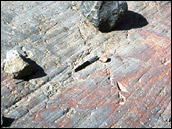
|
| http://earthobservatory.nasa.gov/cgi-bin/rss?/Study/Paleoclimatology/ |
Erosion
In any glacial movement, the underlying rock and earth is modified in some way. Erosion by glaciers can modify rock in
two ways:
In a process called plucking, meltwater moves into cracks present in the bedrock and
is able to refreeze (5). This freezing action will cause the rock to break and dislodge from the bedrock, and can even
freeze these rock particles to the base of the moving glacier (5). The rock within the glacier can now grind against the rock
it is moving over, creating abrasions, which is the second type of glacial erosion. Abrasions are more
pronounced where the glacier is thicker, thus creating a greater pressure on the underlying rocks (6). Such striations are
an indicator of the direction in which the ice moved (5). Any powder that is produced from the grinding of rock is called
rock flour and is composed of very fine particles (6). Meltwater has a tendency to wash away this rock flour and
carry it into streams and lakes, which gives the water a milky green colour (6).
The degree of erosion depends on ice velocity, ice mass and the amount of rock debris it is carrying, not to mention
the type of rock it is moving over. (6)
Glacial Troughs
Valley glaciers will carve into valleys creating glacial troughs which have steep bedrock walls and flat floors. As the
glacier recedes, sediment will fall from the valley walls and alluvial fans are created, giving the valley a U shape (see
Figure 2). (6)
Cirques
The head of the valley, carved out by the glacier is called a cirque. A large amount of snow accumulates on a mountain,
turning into a glacier. Due to the weight of the ice and the force of gravity, the glacier rolls over the threshold and
down into the valley, carving a half-circle shape into the mountain. The ice alone does not carve the mountain wall, but falling
rocks can also grind against the wall by falling into crevasses and being dragged by the glacier ice. (6)
Erosion by Ice Sheets
Ice sheets, though they also erode underlying rock, produce
a different result than valley glaciers. Ice sheets tend to produce a smoother, streamlined effect on the rock. Though erosion
works the same in both cases, ice sheets will scour and smooth the landscape rather than deeply grinding and gouging it. (6)
| Figure 2 - Glacial Trough (click to enlarge) |
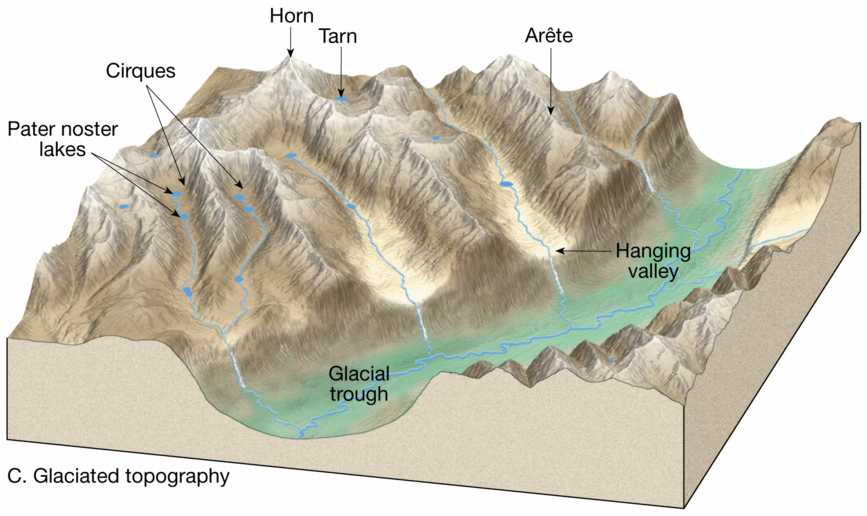
|
| http://oz.plymouth.edu/~sci_ed/Turski/Courses/Earth_Science/Images/8.glaciatedtopo.jpg |
Deposition
As glaciers move, they drag rock particles along with them, carrying a collection of different sized rocks from dust-sized
to boulder-sized, which are all mixed together. This rock collection carried by glaciers will eventually be deposited somewhere
else and is called till. Glaciers have the "strengh" to move gigantic pre-existing boulders from one place to another,
and these large masses of rocks are known as erratics, and can also be an indication of the direction of glacier
movement. (6)
Moraines
A collection of till that has been carried by and deposited
by a glacier is known as a moraine. There are three types of moraines: lateral, medial and end moraines. Lateral
moraines consist of elongated low mounds of till that form along the sides of a valley glacier, often by the accumulation
of fallen rocks along ice edges. A medial moraine is formed when adjacent glaciers come together and the moraines joing along
the same path. End moraines are ridges of debris which has accumulated along the front edge of the glacier. (6)
Picture this! A medial moraine is like the slab of concrete separating the highway from the on-ramp.
The on-ramp road and the highway are merging and moving in the same direction, but there's that small slab of concrete that
separates them for a short distance before turning into that dotted line of the lane. In this scenario, each lane of the highway
would represent the moving glacier with moraines (dotted lines) as lane dividers!
| Glacial Moraine |
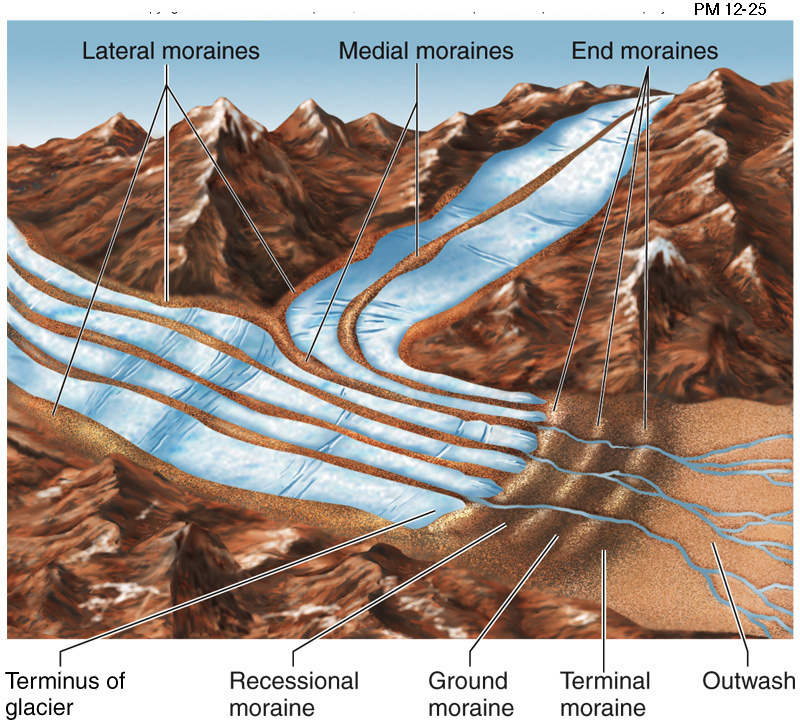
|
| http://www.indiana.edu/~geol116/Week11/wk11.htm |
| Glacial Moraine |
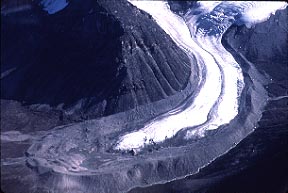
|
| http://www.uwosh.edu/faculty_staff/mode/335_HOME.HTM |
The role of Water
Outwash
Meltwater is a result of melting from the zone of
ablation (as previously discussed). The debris deposited by this meltwater is called outwash, and can be distinguished by
the layered and sorted till deposits consisting mainly of sands and gravels. Two features can arise from the outwash and meltwater,
one of which is an esker. An esker is a long ridge of outwash and can be up to 10 meters high. The second feature
is a kettle: a large depression caused by till-covered ice masses that eventually (after some years) melt. These
depressions are often filled with lakes and can result in the formation of varves. (6)
Did you know? These till deposits are an excellent source of aggregate
to make concrete and roads from! (6)
| Glacial Kettle |
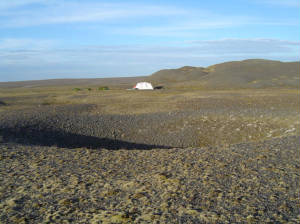
|
| www.hi.is/~oi/glacial_geology_photos.htm |
| Glacial Esker |
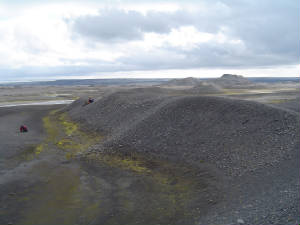
|
| www.hi.is/~oi/glacial_geology_photos.htm |
Click to learn about Ice Ages in the Pleistocene
|

